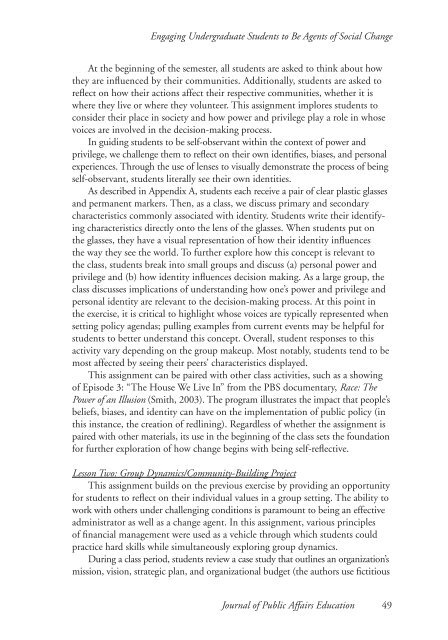Journal of Public Affairs Education
Create successful ePaper yourself
Turn your PDF publications into a flip-book with our unique Google optimized e-Paper software.
Engaging Undergraduate Students to Be Agents <strong>of</strong> Social Change<br />
At the beginning <strong>of</strong> the semester, all students are asked to think about how<br />
they are influenced by their communities. Additionally, students are asked to<br />
reflect on how their actions affect their respective communities, whether it is<br />
where they live or where they volunteer. This assignment implores students to<br />
consider their place in society and how power and privilege play a role in whose<br />
voices are involved in the decision-making process.<br />
In guiding students to be self-observant within the context <strong>of</strong> power and<br />
privilege, we challenge them to reflect on their own identifies, biases, and personal<br />
experiences. Through the use <strong>of</strong> lenses to visually demonstrate the process <strong>of</strong> being<br />
self-observant, students literally see their own identities.<br />
As described in Appendix A, students each receive a pair <strong>of</strong> clear plastic glasses<br />
and permanent markers. Then, as a class, we discuss primary and secondary<br />
characteristics commonly associated with identity. Students write their identifying<br />
characteristics directly onto the lens <strong>of</strong> the glasses. When students put on<br />
the glasses, they have a visual representation <strong>of</strong> how their identity influences<br />
the way they see the world. To further explore how this concept is relevant to<br />
the class, students break into small groups and discuss (a) personal power and<br />
privilege and (b) how identity influences decision making. As a large group, the<br />
class discusses implications <strong>of</strong> understanding how one’s power and privilege and<br />
personal identity are relevant to the decision-making process. At this point in<br />
the exercise, it is critical to highlight whose voices are typically represented when<br />
setting policy agendas; pulling examples from current events may be helpful for<br />
students to better understand this concept. Overall, student responses to this<br />
activity vary depending on the group makeup. Most notably, students tend to be<br />
most affected by seeing their peers’ characteristics displayed.<br />
This assignment can be paired with other class activities, such as a showing<br />
<strong>of</strong> Episode 3: “The House We Live In” from the PBS documentary, Race: The<br />
Power <strong>of</strong> an Illusion (Smith, 2003). The program illustrates the impact that people’s<br />
beliefs, biases, and identity can have on the implementation <strong>of</strong> public policy (in<br />
this instance, the creation <strong>of</strong> redlining). Regardless <strong>of</strong> whether the assignment is<br />
paired with other materials, its use in the beginning <strong>of</strong> the class sets the foundation<br />
for further exploration <strong>of</strong> how change begins with being self-reflective.<br />
Lesson Two: Group Dynamics/Community-Building Project<br />
This assignment builds on the previous exercise by providing an opportunity<br />
for students to reflect on their individual values in a group setting. The ability to<br />
work with others under challenging conditions is paramount to being an effective<br />
administrator as well as a change agent. In this assignment, various principles<br />
<strong>of</strong> financial management were used as a vehicle through which students could<br />
practice hard skills while simultaneously exploring group dynamics.<br />
During a class period, students review a case study that outlines an organization’s<br />
mission, vision, strategic plan, and organizational budget (the authors use fictitious<br />
<strong>Journal</strong> <strong>of</strong> <strong>Public</strong> <strong>Affairs</strong> <strong>Education</strong> 49



